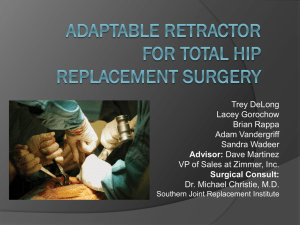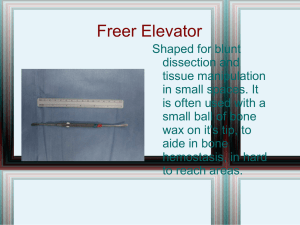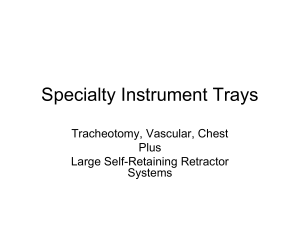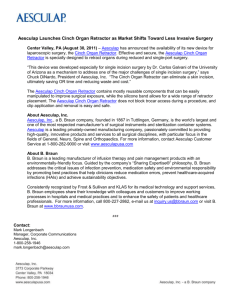D040393
advertisement
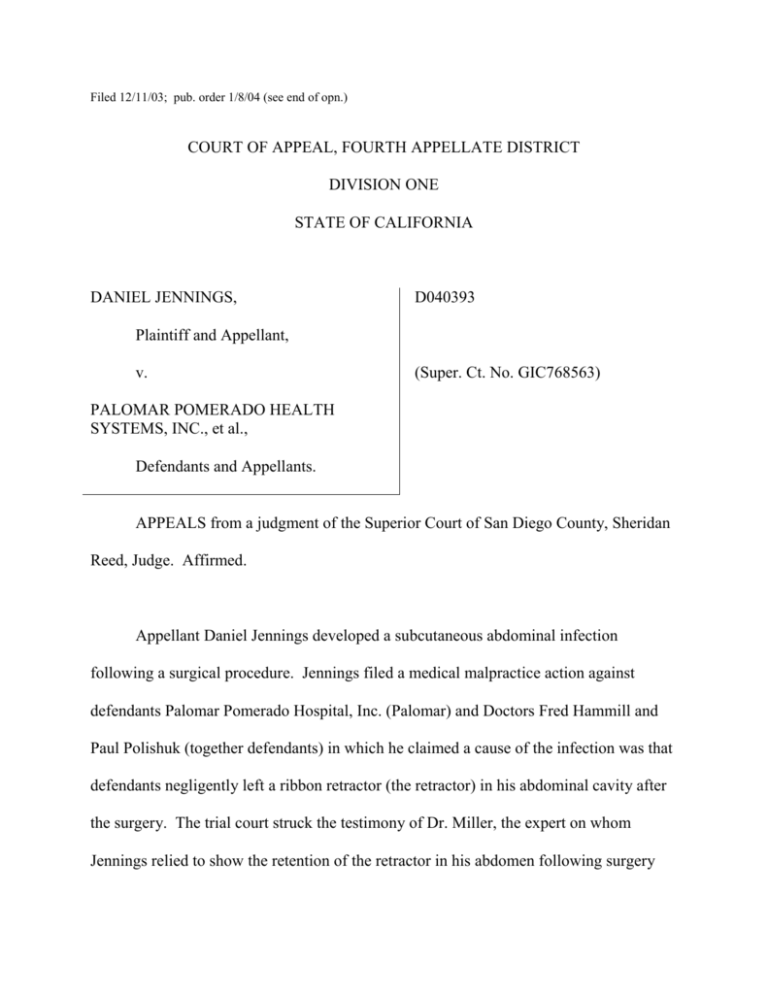
Filed 12/11/03; pub. order 1/8/04 (see end of opn.) COURT OF APPEAL, FOURTH APPELLATE DISTRICT DIVISION ONE STATE OF CALIFORNIA DANIEL JENNINGS, D040393 Plaintiff and Appellant, v. (Super. Ct. No. GIC768563) PALOMAR POMERADO HEALTH SYSTEMS, INC., et al., Defendants and Appellants. APPEALS from a judgment of the Superior Court of San Diego County, Sheridan Reed, Judge. Affirmed. Appellant Daniel Jennings developed a subcutaneous abdominal infection following a surgical procedure. Jennings filed a medical malpractice action against defendants Palomar Pomerado Hospital, Inc. (Palomar) and Doctors Fred Hammill and Paul Polishuk (together defendants) in which he claimed a cause of the infection was that defendants negligently left a ribbon retractor (the retractor) in his abdominal cavity after the surgery. The trial court struck the testimony of Dr. Miller, the expert on whom Jennings relied to show the retention of the retractor in his abdomen following surgery was a cause of the abdominal infection; it concluded Dr. Miller's opinion was based on speculation. On appeal, Jennings argues this ruling was error and seeks a new trial on the issue of economic damages only. Defendants have filed a protective cross-appeal contending that if the judgment is reversed, the new trial should be on the issue of all damages, not on economic damages only. Jennings has moved for sanctions against defendants, contending the cross-appeal is without merit and was filed for purposes of delay. Jennings's appeal against Palomar and Palomar's cross-appeal have been dismissed at the request of Jennings and Palomar, which is no longer a party to this appeal. I FACTUAL AND PROCEDURAL BACKGROUND A. The Surgeries On September 14, 2000, Jennings underwent surgery to correct a colovesical fistula; the surgery was performed by defendants at Palomar. During the surgery, the retractor (a metallic device used to keep the loops of the bowel out of the operating field) was placed in Jennings's abdominal cavity. Following the surgery, Jennings was hospitalized for eight days and experienced significant pain, localized in the surgery's lower incisional line. Although Jennings complained of the incisional pain, he was told this was normal for patients recovering from abdominal surgery. Jennings was then discharged. However, on October 2, 2000, a routine postoperative X-ray revealed the retractor remained in Jennings's abdomen. 2 Jennings was informed that a second surgery to remove the retractor would be required, that surgery was performed on October 3, 2000. During the second surgery, doctors found a large abscess formation, anterior to the fascia, involving most of the upper one-half of the incision. There was liquefaction of the subcutaneous tissue and fascia, and the fascial edge had begun to separate. Before entering the abdominal cavity to remove the retractor, the surgeons first removed the infected subcutaneous tissue and inflamed fascia along the wound edges to prevent the spread of bacteria. The surgeons then entered the peritoneal cavity, an area within the abdomen separated from the rest of the abdomen by a barrier known as the peritoneal wall, and removed the retractor. The retractor was encased in the omentum, a specialized tissue in the abdominal cavity that, upon detecting the presence of inflammation or a foreign body in the abdominal cavity, will encase and contain the inflammation or foreign body. The omentum also contains specialized cells that kill microorganisms. If no infection had occurred following the original surgery to repair Jennings's fistula, he could have returned to work in January 2001. However, the infection necessitated an arduous recovery process, including a third surgery, and as of the date of trial he had not been released to return to work. Because Jennings could not return to work, he lost his job. B. The Infection The infection was located immediately below the skin along the upper one-half of the incision made during the original surgery. Postoperative wound infections are common, and can be caused either by bacteria that reside on human skin or by bacteria 3 released during the surgical procedure that seed the incisional wound during the surgery and then survive efforts to clean the wound before closure. Jennings had an increased risk of a postoperative wound infection because of his age, his weight, and the nature of the particular surgical procedure.1 The subcutaneous infection was separated from the peritoneal cavity in which the retractor had been left by the peritoneal wall, the transversalis fascia, a muscle group covered by the fascia, and the rectus fascia. There were no clinical symptoms suggesting the retractor caused any infection within the peritoneal cavity.2 The October 3 surgical report did not mention any inflammation of the peritoneal cavity or peritoneal wall, and stated the retractor was not encased in pus and the peritoneal wall was intact. C. Procedural Context Jennings's medical malpractice action sought recovery for injuries caused by defendants' failure to remove the retractor during the September 14 surgery. Defendants admitted they were negligent by leaving the retractor in the peritoneal cavity, and 1 Dr. Miller explained that Jennings had risk factors that increased the ordinary risks of postoperative wound infections developing from skin-related bacteria, including his age and the fact that he had a thick layer of subcutaneous fat that could have been seeded with bacteria during or after the surgical procedure. An additional factor increasing the risk of infection was that Jennings's original surgery required surgeons to open the bowel, which released substantial amounts of bacteria into the surgically opened areas. The released bacteria can contaminate the subcutaneous fat, survive efforts to kill bacteria through irrigation and increase the risk of postoperative infections. 2 Prior to the second surgery Jennings did not experience fevers or chills, and his blood tests did not reveal abnormal white cell counts, both of which would normally accompany a major peritoneal infection. 4 Jennings was entitled to recover damages associated with that error, but denied retention of the retractor inside his peritoneal cavity was a cause of the postoperative infection. D. The Excluded Evidence Dr. Miller, whose expertise concerning infectious diseases was not contested, testified that a cause3 of the infection was the fact the retractor was left inside the peritoneal cavity following surgery. His opinion was based on the assumptions that (1) the retractor was placed inside the peritoneal cavity in a contaminated condition,4 and (2) some part of the retractor remained contaminated notwithstanding the pre-closure irrigation of the peritoneal cavity.5 A contaminated retractor enclosed into the abdomen 3 On appeal, Jennings correctly notes that liability attaches if negligence is a substantial factor in causing the injury, and Dr. Miller testified the retained retractor either caused or contributed to the infection. However, on the facts of this case, this is a distinction without a difference. Proof that a negligent act was a substantial factor in causing the injury does not relieve the plaintiff of the burden of proving the negligent act was a cause-in-fact of the injury (Viner v. Sweet (2003) 30 Cal.4th 1232, 1239-1244), and therefore we must test the propriety of the trial court's order striking Dr. Miller's opinion by assuming he sought to opine the retained retractor was a cause-in-fact of the infection. 4 Dr. Miller's assumption the retractor was contaminated before being placed inside the peritoneal cavity was based on the scrub technician's testimony that his gloves had Jennings's bodily fluids on them when the technician handed the retractor to the surgeons near the end of the surgery during the closing procedure. It was undisputed that bacteria released during the surgical procedure could have contaminated Jennings's blood and fluids near the site of the surgical procedure. 5 Dr. Miller acknowledged the operative report reflected that the peritoneal cavity was irrigated with saline before closure, the purpose of this irrigation is to sterilize any remaining bacteria within the peritoneal cavity at the end of the operative procedure before the peritoneal wall is sutured closed, and the retractor could have been sterilized by exposure to the saline solution. However, he theorized that some part of the retractor might not have been exposed to the saline solution because a loop of the bowel could 5 can become a nidus (or focal point) where unsterilized bacteria can grow. Dr. Miller testified that, during the window of time commencing with closure of the incision and ending when the contaminated retractor became encased by the omentum,6 bacteria migrated from the peritoneal cavity to the subcutaneous tissue and therefore was a causein-fact of the postoperative infection. However, Dr. Miller's articulated explanation of the etiology of the infection--that bacteria on the retractor multiplied and migrated through the sutured peritoneal wall, and then continued migrating outward through the transversalis fascia, the muscle group, and the rectus fascia before finally seeding into the subcutaneous tissue--was conclusory. His explanation was, in essence, that because the retractor was left in place and was probably contaminated, and a nearby area later became infected, "[i]t just sort of makes sense. We have that ribbon retractor and its contaminated, he's infected." Dr. Miller's opinion on the causal linkage between the retained retractor within the peritoneal wall and an infection outside the peritoneal wall was therefore based on an ipso facto explanation. Dr. Miller did suggest two hypothetical scenarios containing reasoned links between the bacterial contaminants on the retractor and the infection in the subcutaneous have adhered to the retractor and blocked the saline from eliminating the bacteria on that portion of the retractor. 6 Dr. Miller explained that the omentum, upon sensing the presence of the foreign body, would quickly encase and "wall off" the foreign object. He estimated that, considering the size of the retractor here, the omentum probably required approximately 24 hours to enclose the retractor and wall off further danger of bacterial infection from that nidus. He opined the peritoneal wall can also form its seal within 24 hours, while the fascia takes a little longer to form its seal. 6 tissue. First, he opined that bacteria on the retractor could have seeded the subcutaneous fat as the retractor was being lowered through the incision for placement inside the abdomen preparatory to closure of the peritoneal wall. However, because Jennings's theory of liability was not based on placing the retractor into the abdomen during the procedure, but was instead premised on injuries caused by not removing the retractor at the end of the procedure, this potential etiology of the infection is not germane to Jennings's claim. Dr. Miller's second hypothetical scenario was that the sutures could have become contaminated by the bacteria on the retractor and then the suture "drag[ged] dirty things back up" to the subcutaneous tissue. However, he conceded this was speculative, and there was no evidence that retention sutures passing through the peritoneal wall were used during the original surgery. Additionally, he stated that this etiology for migration of the bacteria would have occurred while the suturing was being performed, and this seeding of the tissue would have been instantaneous and therefore occurred even if at the end of the procedure the retractor had been removed. Because Jennings's claim of causation rested on proof the infection was caused by leaving the retractor in situ, the suture explanation was not germane to Jennings's claim. F. The Trial Court's Ruling Defendants moved for an order striking Dr. Miller's testimony, arguing that his testimony on causation was without foundation because it was based on factual assumptions without evidentiary support and too speculative to satisfy the standard that it was more probable than not that the retractor was a cause of the infection. Jennings opposed the motion, asserting that Dr. Miller was qualified to express an opinion on the 7 etiology of this infection, his opinion had an adequate foundation, he had stated the contaminated retractor was a cause of the infection to a reasonable degree of medical certainty, and there was no evidence of any other cause of the infection.7 Accordingly, Jennings argued the court was obligated to admit the testimony of Dr. Miller and to leave it for the jury to decide whether to credit Dr. Miller's opinion or the contrary opinion of defendants' expert on whether the failure to remove the retractor was a cause of the infection. The trial court granted the motion to strike on the grounds that Dr. Miller's testimony did not show how the fact the retractor was not removed in the course of the original surgery was causally linked to the subsequent subcutaneous infection. Jennings's remaining claims for damages proceeded to the jury,8 and the jury awarded Jennings 7 On appeal, Jennings implicitly suggests something akin to a res ipsa loquiter theory of causation by quoting a portion of the testimony in which Dr. Miller stated there was no evidence that anything other than the retained retractor could account for this infection. However, this snippet of conclusory testimony does not buttress Dr. Miller's opinion on causation, because he admitted (1) patients do not always develop infections when foreign bodies are not removed, (2) he regularly treats patients who have developed postoperative wound infections where no foreign body was left inside, and (3) the same infection could have been caused either by contaminants seeding the tissue during the surgical procedure or by postoperative infection caused by skin bacteria infecting the surgical incision. 8 The court, in ruling on the motion to strike, noted there was no dispute that leaving the retractor in place breached the standard of care, and although Jennings had not demonstrated the infection was caused by the retractor, he was nevertheless entitled to recover for the physical and emotional distress and economic losses caused by retention of the retractor and the second surgery that was necessary to remove the retractor. 8 $255,000 in noneconomic damages (reduced to $250,000 pursuant to Civ. Code, § 3333.2) and $5000 in economic damages. These appeals followed. II ANALYSIS A. Admissibility of Expert Testimony A person who qualifies as an expert may give testimony in the form of an opinion if the subject matter of that opinion "is sufficiently beyond common experience that the opinion of [the] expert would assist the trier of fact." (Evid. Code, § 801, subd. (a); People v. Gardeley (1996) 14 Cal.4th 605, 614.) It is undisputed that qualified medical experts may, with a proper foundation, testify on matters involving causation when the causal issue is sufficiently beyond the realm of common experience that the expert's opinion will assist the trier of fact to assess the issue of causation. However, even when the witness qualifies as an expert, he or she does not possess a carte blanche to express any opinion within the area of expertise. (Summers v. A. L. Gilbert Co. (1999) 69 Cal.App.4th 1155, 1178.) For example, an expert's opinion based on assumptions of fact without evidentiary support (Pacific Gas & Electric Co. v. Zuckerman (1987) 189 Cal.App.3d 1113, 1135), or on speculative or conjectural factors (Lockheed Martin Corp. v. Superior Court (2003) 29 Cal.4th 1096, 1110-1111), has no evidentiary value (McGonnell v. Kaiser Gypsum Co. (2002) 98 Cal.App.4th 1098, 1106) and may be excluded from evidence. (City of San Diego v. Sobke (1998) 65 Cal.App.4th 379, 396; cf. Young v. Bates Valve Bag Corp. (1942) 52 Cal.App.2d 86, 96.) Similarly, when an expert's opinion is purely conclusory because unaccompanied by a reasoned 9 explanation connecting the factual predicates to the ultimate conclusion, that opinion has no evidentiary value because an "expert opinion is worth no more than the reasons upon which it rests." (Kelley v. Trunk (1998) 66 Cal.App.4th 519, 523-525.) Exclusion of expert opinions that rest on guess, surmise or conjecture (Lockheed Martin Corp. v. Superior Court, supra, 29 Cal.4th 1096) is an inherent corollary to the foundational predicate for admission of the expert testimony: will the testimony assist the trier of fact to evaluate the issues it must decide? (Summers v. A. L. Gilbert Co., supra, 69 Cal.App.4th 1155 at pp. 1168-1169 [expert opinion admitted if it will assist jury and will be excluded when it "would add nothing at all to the jury's common fund of information"].) Therefore, an expert's opinion that something could be true if certain assumed facts are true, without any foundation for concluding those assumed facts exist in the case before the jury, does not provide assistance to the jury because the jury is charged with determining what occurred in the case before it, not hypothetical possibilities. (Cf. McGonnell v. Kaiser Gypsum, supra, 98 Cal.App.4th at pp. 11051106.) Similarly, an expert's conclusory opinion that something did occur, when unaccompanied by a reasoned explanation illuminating how the expert employed his or her superior knowledge and training to connect the facts with the ultimate conclusion, does not assist the jury. In this latter circumstance, the jury remains unenlightened in how or why the facts could support the conclusion urged by the expert, and therefore the jury remains unequipped with the tools to decide whether it is more probable than not that the facts do support the conclusion urged by the expert. An expert who gives only a 10 conclusory opinion does not assist the jury to determine what occurred, but instead supplants the jury by declaring what occurred. B. Expert Testimony on Causation The ruling excluding Dr. Miller's testimony cannot be assessed in a vacuum, but must instead be considered through the prism of the purpose for plaintiff's proffer of his opinion. In a medical malpractice action, a plaintiff must prove the defendant's negligence was a cause-in-fact of injury. (Bromme v. Pavitt (1992) 5 Cal.App.4th 1487, 1502.) "The law is well settled that in a personal injury action causation must be proven within a reasonable medical probability based [on] competent expert testimony. Mere possibility alone is insufficient to establish a prima facie case. [Citations.] That there is a distinction between a reasonable medical 'probability' and a medical 'possibility' needs little discussion. There can be many possible 'causes,' indeed, an infinite number of circumstances [that] can produce an injury or disease. A possible cause only becomes 'probable' when, in the absence of other reasonable causal explanations, it becomes more likely than not that the injury was a result of its action. This is the outer limit of inference upon which an issue may be submitted to the jury. [Citation.]" (Jones v. Ortho Pharmaceutical Corp. (1985) 163 Cal.App.3d 396, 402-403, italics added; accord, Osborn v. Irwin Memorial Blood Bank (1992) 5 Cal.App.4th 234, 253 [although plaintiff need not eliminate any possibility that defendant's conduct was not a cause, he must introduce " 'evidence from which reasonable [people] may conclude that it is more probable that the event was caused by the defendant than that it was not' "].) 11 Thus, proffering an expert opinion that there is some theoretical possibility the negligent act could have been a cause-in-fact of a particular injury is insufficient to establish causation. (Saelzler v. Advanced Group 400 (2001) 25 Cal.4th 763, 775-776 [expert testimony positing a " 'mere possibility of such causation is not enough; and when the matter remains one of pure speculation or conjecture, or the probabilities are at best evenly balanced, it becomes the duty of the court to direct a verdict for the defendant' "]; accord, Leslie G. v. Perry & Associates (1996) 43 Cal.App.4th 472, 487.) Instead, the plaintiff must offer an expert opinion that contains a reasoned explanation illuminating why the facts have convinced the expert, and therefore should convince the jury, that it is more probable than not the negligent act was a cause-in-fact of the plaintiff's injury. C. Evaluation We must decide, within the above framework, whether the trial court erred in striking Dr. Miller's testimony.9 9 The parties do not agree on the standard that governs our review of the trial court's ruling. Defendants cite numerous cases that have applied the abuse of discretion standard to rulings on the admissibility of expert testimony, but most of those cases involved rulings on whether the witness was qualified to express the opinion (see, e.g., People v. Catlin (2001) 26 Cal.4th 81, 131-133), or whether it was a proper subject of expert testimony (see, e.g., Summers v. A. L. Gilbert Co., supra, 69 Cal.App.4th 1155, 1178), issues not present here. In contrast, Jennings argues we should import the standards applicable to review of an order granting a nonsuit because the effect of the ruling was to nonsuit Jennings on a substantial portion of his damage claim (cf. Aas v. Superior Court (2000) 24 Cal.4th 627, 634-635) and the nonsuit standard was applied sub silencio by the trial court. Under the nonsuit standard, Jennings argues the ruling would be proper only if Dr. Miller's testimony, viewed most favorably to Jennings and given all the value to which it was legally entitled, and disregarding all conflicting testimony, could not support a verdict in Jennings's favor on the issue of causation. (Cf. Espinosa v. Little Co. of Mary Hospital (1995) 31 Cal.App.4th 1304, 1313.) We view the standard of review issue in 12 Dr. Miller's opinion had two aspects. First, he testified that, if a constellation of events had coalesced, the retractor could have provided a nidus for bacteria to grow inside Jennings's peritoneal cavity during the window of time ending when the retractor became encased by the omentum.10 Although Dr. Miller may have been qualified to provide that opinion, and his testimony may have included matters sufficiently beyond common experience to assist the trier of fact to decide what may have transpired within the peritoneal cavity, it was not helpful to the jury absent additional evidence that it was more likely than not that bacteria growing around the retractor migrated to and were a cause-in-fact of the infection in the subcutaneous tissue. Second, Dr. Miller testified that bacteria growing around the retractor were a cause-in-fact of the infection. However, that opinion was too conclusory to satisfy the requirements for admissibility. (Cf. Thai v. Stang (1989) 214 Cal.App.3d 1264, 1276 [expert's conclusory declaration regarding causation not competent evidence raising issue this case as one in which otherwise distinct standards of appellate review merge into a single approach. (Cf. In re Jasmine D. (2000) 78 Cal.App.4th 1339, 1351.) That is, if an expert's opinion on causation would (if credited by the jury) provide legally sufficient support for a finding in the plaintiff's favor on the issue of causation, it would be an abuse of discretion to strike that testimony. We therefore examine the ruling giving to Dr. Miller's opinion " ' "all the value to which it is legally entitled [and] indulging every legitimate inference [that] may be drawn from the [opinion] in [Jennings's] favor." ' " (Espinosa v. Little Co. of Mary Hospital, supra.) 10 The events that would have produced this result are (1) the bacteria released into Jennings's bodily fluids during the surgical procedure survived the periodic irrigations during the procedure, (2) surviving bacteria found their way onto the gloves worn by the scrub technician, (3) these bacteria was then transferred onto the retractor before it was placed inside Jennings, and (4) the contaminated portions of the retractor escaped sterilization from later irrigations. 13 of fact on causation].) Although Dr. Miller testified the retractor was a cause-in-fact of the infection, his conclusion was unaccompanied by any reasoned explanation supporting his opinion.11 (See Ochoa v. Pacific Gas & Electric Co. (1998) 61 Cal.App.4th 1480, 1487; Nola M. v. University of Southern California (1993) 16 Cal.App.4th 421, 436, fn. 8.) Dr. Miller never articulated why or how it was more likely than not that the bacteria, after multiplying without any clinical symptoms that ordinarily accompany peritonitis, migrated from the nidus within the peritoneal cavity through the sutured peritoneal wall, and then through the transversalis fascia, the muscle group and the rectus fascia, finally settling into the subcutaneous tissue, while leaving the peritoneal wall intact and leaving behind no trail of inflamed or infected tissue evidencing this migration. Instead, Dr. Miller substituted a conclusion in place of an explanation, opining "[i]t just sort of makes sense. We have that ribbon retractor and its contaminated, he's infected."12 11 We acknowledge that Dr. Miller was asked to explain his reasons for opining the retractor had some effect on the infectious process, and he responded. However, his response was: "Not to be redundant, but I view that the germs were . . . present in the initial surgery, [were] in the operative field, and there were some germs associated with the retractor, and then when the wound was closed up, there were still germs in the tissue [that] were closed up. So I view this as a--the term is contiguous, that is, everything is connected. It's just that the peritoneum was just closed off with retention sutures, and the omentum is left to do its job in the abdomen, and then the skin part of the infection then blossomed over the next couple of weeks." While this explanation accounts for the subcutaneous tissue infection, it does not explain how the enclosed peritoneal nidus of bacteria was causally connected to the subcutaneous tissue infection. 12 Jennings appears to argue on appeal that a conclusory opinion by an expert is admissible and sufficient to demonstrate causation, asserting that "Dr. Miller's statement that his opinion makes common sense--which in his case in the common sense of a highly qualified infectious disease specialist--did not convert his opinion into speculation." Accordingly, Jennings argues, the court should have admitted this conclusion into 14 That opinion is too conclusory to support a jury verdict on causation. (Saelzler v. Advanced Group 400, supra, 25 Cal.4th at pp. 775-776.) Dr. Miller's opinion was not supported by a reasoned explanation illuminating the etiology connecting the infected subcutaneous tissue to the nidus inside the peritoneal cavity where the retractor was retained, and did not contain a reasoned explanation accounting for or reconciling his theory with the apparent lack of inflammation or infection along the theorized migratory route. The opinion was therefore inadmissible under Evidence Code section 801 because it could not assist the jury to perform its role of determining whether it was more probable than not that the retention of the retractor in the peritoneal cavity of the abdomen contributed to the infection in the subcutaneous tissue. D. Sanctions Because we affirm the judgment, defendants' cross-appeal is moot. Jennings's motion for an award of appellate sanctions based on defendants' filing of their crossappeal argues both that the cross-appeal is totally without merit and that it was filed evidence and left to the jury to evaluate the weight between Dr. Miller's conclusion and the opinion expressed by defendants' experts. This argument does not detract from, but to the contrary reinforces, our view that Dr. Miller's conclusion was properly excluded, because an expert who expresses a conclusion supported only by a statement telling the jury (in essence), "Trust me, I'm an expert, and it makes sense to me" has provided no grist for the jury's decisional mill. Instead, such a conclusion leaves to the jury only a weighing of the curricula vitae of the opposing experts. We are convinced the expert must provide some articulation of how the jury, if it possessed his or her training and knowledge and employed it to examine the known facts, would reach the same conclusion as the expert. 15 solely for the purposes of delay or harassment. We conclude neither standard is satisfied here and therefore deny Jennings's request for sanctions. DISPOSITION The judgment is affirmed. Jennings's request for sanctions is denied. Defendants are entitled to costs on appeal. McDONALD, J. WE CONCUR: HALLER, Acting P. J. O'ROURKE, J. 16 COURT OF APPEAL, FOURTH APPELLATE DISTRICT DIVISION ONE STATE OF CALIFORNIA DANIEL JENNINGS, D040393 Plaintiff and Appellant, v. (Super. Ct. No. GIC768563) PALOMAR POMERADO HEALTH SYSTEMS, INC., et al., ORDER CERTIFYING OPINION FOR PUBLICATION AND DENYING REHEARING Defendants and Appellants. THE COURT: The opinion filed December 11, 2003, is ordered certified for publication. The attorneys of record are: Law Offices of J. G. Maiorano, Joseph G. Maiorano; Klinedinst, Fliehman & McKillop, Kendra J. Hall and Carey L. Cooper for Plaintiff and Appellant. Thelen Reid & Priest, Curtis A. Cole, Kenneth R. Pedroza and Chanda R. Weber for Defendants and Appellants. Horvitz & Levy, David M. Axelrad and Mary-Christine Sungaila for California Medical Association, California Hospital Association and California Dental Association as Amici Curiae on behalf of Defendants and Appellants. The petition for rehearing is denied. 17

